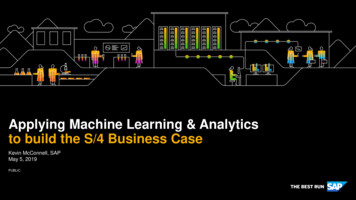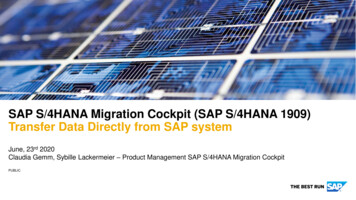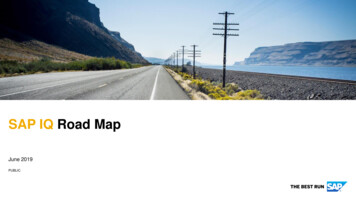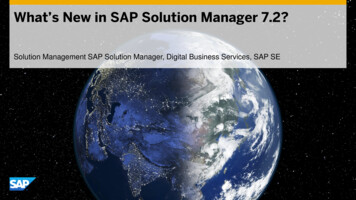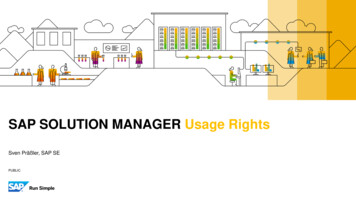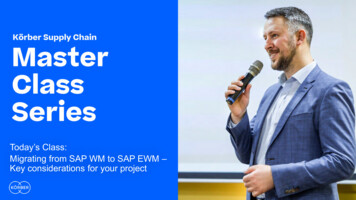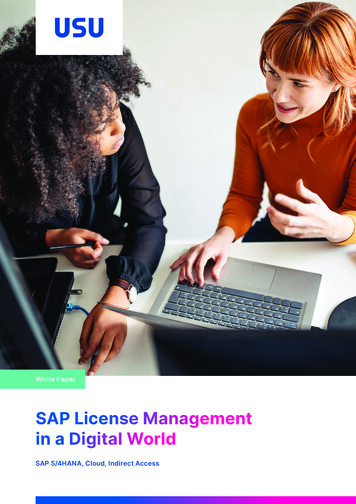
Transcription
White PaperSAP License Managementin a Digital WorldSAP S/4HANA, Cloud, Indirect Access
ContentIntro3SAP License Management as an Opportunity4The First Steps to SAP S/4HANA Migration4SAP Cloud Products: A Trend Towards Simplification?6Cloud Credits – and How to Interpret Them8What is Changing? With SAP Hybris as an Example9Current and New Licensing Model, Indirect Access13Conclusion21
IntroLicense Management for SAP – why?SAP customers face major changes worldwide – new measurement methods and pricingmodels for indirect access, the upcoming migration to SAP S/4HANA, the launch ofcountless new SAP cloud products, and the uncertainty between usage-based andrights-based user licensing – that catapult SAP customers into a licensing labyrinth.Many customers have already lost track of the SAP licenses they require now, and in thefuture, often unknowingly. SAP license management is often not about keeping an overallperspective but getting one for the first time. In addition to clarity and transparency, it isalso about investment protection and return on investment (ROI) – in short, avoidingunpredictable costs.This white paper will help you take the first step in managing your SAP estate, to beaware of the new challenges, demonstrate approaches to a solution, and suggest actions.White Paper SAP License Management in a Digital World3
SAP License Managementas an OpportunityMany SAP managers, along with CTOs and CIOs,It is important to make strategic business decisionsare not yet aware of the great change their companieswith experience and know-how, but also have thecurrently face. But right now, there is an opportunitycourage to be creative and share a vision. Thisto clean up legacy issues, revise outdated processes, requires teamwork, because license managementand build a future-proof architecture. Software willcannot be solved by one person or team. Supportultimately become a competitive advantage thatfrom specialized external consultants is increasinglymaintains a strong market position in the future.important. They will be highly sought after in thecoming years and scarce on the market.The First Steps toSAP S/4HANA MigrationSAP recommends clients transfer to the new S/4HANAbe invoiced in three ways: purchase plus support,technology early, before the scheduled end of supportrental, or usage. The measurement also changesfor the classic SAP Business Suite in 2025. A completeaccording to the type of purchase. This appliestransfer is estimated to last two to three years,regardless of where the SAP systems are operated depending on the size of the environment. With a(on-premises, private cloud, public cloud). However,greenfield approach, this can easily become five toeach type of license has its own measurement tools.six years. Alongside the technical migration, the SAPcontract is also converted. It is great opportunity toA notable example: licensing users based on theirclear up legacy issues – and this applies equally toauthorizations is mandatory for the customer – unlessprocesses, outdated in-house developments, unusedcustomers can negotiate this differently in their S/4licenses, and existing contracts.contract. The number of different user types is alsosignificantly reduced, which in turn limits the possibilityFundamentally nothing has changed with SAP’sfor differentiation. If these license types do not suitmeasurement methods. There will still be user-basedyour business, you should customize them.licenses and usage-specific metrics. The licenses canIf you look at the Prices and Conditions List closely, you will realize thatSAP is using the transition to redefine many details of the license metrics.Guido Schneider, Senior Product Management Advisor SAP, USUWhite Paper SAP License Management in a Digital World4
How will SAP accountsbe measured in future?SAP points out in its current Prices and Conditions Listadjust the authorization concept to the underlyingthat usage of S/4HANA is based on potential use, whichsolution functions. However, the organization must alsomeans that in S/4HANA systems, the authorizationsfit to these new license types. It is foreseeable that thisassigned there for the necessary license types shouldwill not be the case for all customers, so it makes sensebe taken into consideration, and not the actual usage.to negotiate with SAP over the functionalities of thesethree new types of license.With S/4HANA Compatibility Packs, SAP offers customers an opportunity to continue using previouslylicensed functionalities in the new S/4HANA world. Onmigrating to SAP S/4HANA, in addition to the systemrequirements and components used, the authorizationsmust also be checked and adjusted if necessary. In SAPConclusionS/4HANA, some transactions have been replaced byAn optimized authorization concept, whichnew transactions and SAP Fiori apps, or deletedalso takes the license metrics into account,without replacement.is the foundation for the best S/4HANA licenseNew: Professional Use, Functional Use, Productivity UseWith S/4HANA, there are three new user licenses:migration. Since there will be new transactionsand old ones will become obsolete, the rightsconcept must also be technically reviewed andadapted. It is a good opportunity to do bothat once. This saves time and money.Professional Use, Functional Use, and Productivity Use.To use these correctly in the future, it makes sense toThree steps to successfullicense migration:01 Optimize the existing license requirements basedon actual usage02 Introduce an authorization concept that accountsfor license metrics and adjusts authorizations to usage03 Analyze the effects (on your license landscape)in an S/4 HANA migrationThese three steps, and using an appropriate SAMtool to automatize the process, provide continuoustransparency on your own user license requirements –even in the new hybrid system landscape.White Paper SAP License Management in a Digital World5
SAP Cloud Products: A TrendTowards Simplification?SAP brings integrated enterprise to cloud.Bill McDermott, 2014With this statement, SAP’s chief executive officer described the clear direction for SAP at theWorld Economic Forum in February 2014. The consequences of focusing on “Cloud first” hasbeen keenly felt since. The takeover and integration of cloud-based providers such as Concur,Fieldglass, Hybris, Ariba, and SuccessFactors has made a significant contribution to this.SAP Cloud SaaS application licensing modelRights to several servicesCloud CreditsCloud CreditsUsage-basedSurplusPay as you goBusinessmodelsRental(individual services/package)It’s clear the “rental price” is not the only license element to consider. In addition, a furtherlicense model – “the usage-based model” – with additional options comes into play.White Paper SAP License Management in a Digital World6
The following elements should be consideredwith SAP Cloud SaaS licensing: Private or public cloud environment Functionalities and services included in the annualrental price (type of support, SaaS components in thechosen product) Duration of the initial term (usually three to five years)and the extension period (often one to three years) Rental or usage-based model (for many products inthe public cloud, such as SAP Fieldglass, SAP Ariba, Price (per year/month or one-off)and SAP Cloud Platform, you can choose between License scope (monitored usage, graduated pricescale)rental and usage-based licensing models) Usage-based model: Cloud Credits and/or Pay as Licensing metrics (e.g. users, resources, devices,transactions, etc.)you go SAP is also working on expanding the usage-basedlicensing model to products like SAP SuccessFactorsRental model vs. usage modelRental modelUsage model(recurring annual fees)(invoicing based on actual usage)Software usagerightsDatabaseMaintenance, appmgmt & support License scopeMetrics Price Contract length FunctionalitiesType of support(Enterprise/Premium)HardwareSoftware usagerightsDatabaseMaintenance, appmgmt & support License scopeMetrics Price Contract length FunctionalitiesType of support(Enterprise/Premium)HardwareExamples: SAP S/4HANA; SAP C/4HANA; SAP Concur ,Examples: SAP Cloud Platform, SAP Ariba, and SAPSAP Ariba , and SAP SuccessFactors Solutions; SAPFieldglass SolutionsCloud Platform; and SAP BusinessObjects SolutionsRental-based model versus usage-based model: For customers, there isgreater complexity in the design of their system landscape and the licensemetrics to be used.White Paper SAP License Management in a Digital World7
Cloud Credits –and How to Interpret ThemBy launching cloud credits with the usage-based licensing model, SAPis seeking to introduce flexible models and, at the same time, createtransparency by providing customers with monthly information aboutusage of cloud credits.Commercial aspectsUsage aspects Cloud credits are discount-relevant Cloud credits give the right to flexible use of Cloud credits are prepaid commitments fora defined time period – unused cloud creditsare retained Cloud credits can be topped up at any timeall usage-based services in the SAP portfolio Use of services is charged against cloudcredits Excess use (“excess”) is invoicedThere is still a long way to go before customers canmonitor the usage of an entire SAP portfolio in atransparent and efficient way.ConclusionYour key goal as a customer should be complete,This shows that SAP clearly favors the rental and usagethorough transparency on your current costs,model with the new licensing and, despite the desire tolicense volume, and actual usage. This issimplify, it is not reducing complexity here. In the SAPindispensable for an optimized cost structureAriba field alone, there are four different users and 26and one of the core tasks of SAP licenseusage-specific metrics. The combination of existingmanagement in the future. SAP provides youusage rights, such as SAP Process Orchestration, andwith limited support, which makes the use ofnew ones, like SAP Cloud Platform Integration Option,an independent solution absolutely necessary.raises further issues because there are usually severaloptions that the customer can implement technicallyRecommendationand map from a licensing perspective.Consider a tool-based SAM solution for SAPlicenses. It must have the ability to integrate thetraditional licensing model of the on-premisesworld, on the one hand, and cover the dynamicmarket of cloud scenarios and the existingusage models there, on the other.Make sure the solution not only provides thecurrent status of your license usage but knowsall the various possibilities for usage rights fromthe Price and Conditions List and proactivelyshows you potential savings.White Paper SAP License Management in a Digital World8
What is Changing? WithSAP Hybris as an ExampleLet’s look at one of the biggest SaaS products: SAP Hybris, or C/4HANA,and its licensing model.Following the introduction of SAP C/4HANA, “Hybris”(a solution that provides information, such as pricing,should disappear from our SAP terminology and becommissions and performance bonuses, to salesmarketed as in-memory customer experience (CX).people) and CoreSystems (a field services module) –Together with the most recent acquisitions – GigyaHybris represents “SAP’s new CRM.”(customer identity management), CallidusCloud SAP C/4HANASAP C/4HANASAP MarketingCloudSAP CommerceCloudSAP SalesCloudSAP ServiceCloudSAP Customer Data CloudMicro servicesInternet of thingsSAP Cloud Platform Extension FactoryMachine learningSAP Cloud PlatformExtensionsChain trackIntegrationSAP S/4HANAWhite Paper SAP License Management in a Digital World9
SAP C/4HANA comprises existing s olutionsfrom the Hybris worldSAP Marketing Cloud, also known as “SAP Hybris Marketing” – apart from rebranding, nothinghas changed in the pricing model or the solution itself.SAP Marketing CloudRental model of SAP Marketing Cloud Consumer and customer profiling Segments, campaigns und customer journeys StandardEdition Customer identity management Professional Enterprise Lead management and nurturing Marketing planning, performance, and analyticsMetrics ContractsPrice Graduated price scaleFees MonthlyNB: As of July 2018SAP Commerce Cloud, also known as “SAP Hybris Commerce” – as with SAP Marketing Cloud,nothing has changed except SAP Commerce Cloud will also be available on the Microsoft Cloudplatform Azure.SAP Commerce CloudRental model of SAP Commerce Cloud Supports B2C, B2B and B2B2C Product content and order management StandardEdition Pre-built integrations to other SAP systems Professional Enterprise Flexibility for innovationen Industry accelerators Commerce for small and midsize enterprises OrdersMetrics Gross value ofmerchandise Page viewsPrice Graduated price scaleFees MonthlyNB: As of July 2018White Paper SAP License Management in a Digital World10
SAP Sales Cloud comprises SAP Hybris Sales Cloud 4C Sales for sales force automation,Revenue Cloud for subscriptions, and CallidusCloud for commission settlement plus configure,price and quote (CPQ).SAP Sales CloudRental model of SAP Sales Cloud Standard Sales force automation Sales performance management Retail execution ProfessionalEdition Enterprise Private* Configure, price and quote Subscription billing Sales enablement and learning UsersMetrics Flat fee*Price Per userFees MonthlyNB: As of July 2018*Only if SAP Sales Cloud and Service Cloudare purchased togetherSAP Service Cloud comprises SAP Hybris C4C Service and SAP’s latest acquisition, CoreSystems. This replaces the Field Service of C4C and caters to the operation of supplychain service processes.SAP Service CloudRental model of SAP Service Cloud Standard Comprehensive self-services Customer service from anywhere Integrated on-site serviceEdition Professional Enterprise Private* Services process and operations Automated AI customer service ticketing Expedited, scalable issue resolutionMetrics Users Flat fee*Price Per userFees MonthlyNB: As of July 2018*Only if SAP Sales Cloud and Service Cloudare purchased togetherWhite Paper SAP License Management in a Digital World11
SAP Customer Data Cloud involves Gigya solutions to handle all data protection topics, such asrights and authorization management.SAP Customer Data CloudRental model of SAP Customer Data Cloud Secure customer identityEdition Not applicableMetrics ContactsPrice Graduated price scaleFees Monthly Enable customer consent Single unified customer profile Building digital relationships Drive registrations and engagement Address GDPR requirementsNB: As of July 2018Products: SAP Customer Identity,SAP Customer Consent, SAP Customer ProfileConclusionSAP products will continue to changein the future, it’s just happening at anever-faster pace. SAP presents this asa major advantage, but new processesmust always be introduced or existingones changed. These products must firstprove themselves and contribute to SAPcustomers’ revenue. Flexibility is goodand important, but you should be carefulnot to lose sight of your goal. Thecustomer is still always the focus –your customer!RecommendationTake a step-by-step approach to newagile products, as you create addedvalue with them. This allows you toconvince colleagues and critics oftheir importance.White Paper SAP License Management in a Digital World12
Current and New LicensingModel, Indirect AccessIn April 2018, SAP presented a new licensing model that involves changes around indirect access. Let’s look at the real fundamentalsof indirect access and the essential features of the current and newlicensing model. What challenges do you face as an SAP customer?White Paper SAP License Management in a Digital World13
Current licensing modelThe current model basically provides a combination of a package licenseand named user license for use as a key factor in the licensing requirement.Package licensesNamed user licensesPriced by business metricsPriced by number of usersHowever, with indirect access there is deviation from this basic model in certainscenarios and under certain conditions. The three existing access types look like this:Access types in the current licensing modelDirect/human accessUser-basednamed user licenseIndirect/digital AccessSAP ERPDigital CoreS/4 HANADocument-based(primary)SAP application access**no additional ERPlicense requiredSource: SAP, SAP Pricing Update 180420 PKL 02/2018, p. 16Key exceptions: In most cases, no license fees are due if data is only read.White Paper SAP License Management in a Digital World14
SAP ECC or S/4 HANA Enterprise ManagementCreate queryInformation extractedautomatically on ascheduled basisNo updates to ECCsystem triggered by3rd party appStatic data in 3rd party systemSAP licensed user3rd party application user3rd party application userSource: SAP, Indirect Access White Paper July 2017, p. 9Indirect static read scenarioAn exception with regard to (for) defined users: Ifapplications and/or their users as part of this agreementdata from purchased software (with the exceptionrequires NO usage rights, insofar as such use doesof any SAP Business Warehouse software and/ornot infringe on updates to the purchased softwarethird-party databases) is exported to non-SAPand/or processing functions of the purchased software. applications in line with a predefined query that (i)“Non-SAP application(s)” refers to technologies that arewas created by a person who was authorized to usenot purchased software and for which the customer hasthe software from which the data were exported andpurchased appropriate usage rights from a rights holder(ii) will be automatically executed in accordance withother than SAP, SAP SE and/or one of its affiliateda set timetable, the use of such data by non-SAPcompanies and/or distributors.White Paper SAP License Management in a Digital World15
The new licensing modelEven after the rollout of the new licensing model, youwill search in vain for a definition of indirect access inthe SAP general terms and conditions and the SAPPrice and Conditions List, which are usually part ofcustomer contracts. There is also no definition ofindirect access or indirect usage in the relevant legalfoundations. If you look for the definition of “use” in theSAP Price and Conditions List to clarify the issue, thereis scope for interpretation and critical explanation.‘Use’ means to activate the processingcapabilities of the software, load, execute,access, employ the software, or display information resulting from such capabilities.Use may occur by way of an interface delivered with or as a part of the software,a Licensee or third/party interface, oranother intermediary system.Source: SAP List of Prices and Conditions 2018/3,Part 2, 1.1.1 no. 7.Indirect/Digital Access is when peopleor things use the Digital Core without directly logging into the system. It occurswhen humans, any device, or system,indirectly use the Digital Core via non-Overall, indirect access is understood to be aparticular form of usage pursuant to the SAPPrice and Condition List.SAP intermediary software, such as anon-SAP front end, a custom-solution,or any other third-party application.Source: SAP ERP Pricing for the Digital Age,This is also supported by the way SAP describesindirect access in other SAP documents – albeit forinformation only, without being legally binding.Addressing Indirect/Digital Access, April 2018White Paper SAP License Management in a Digital World16
The new licensing model unveiled by SAP in Aprilapplication access. Licensing of direct/human access2018 alters the provisions for the usage/access type ofis still based on the number of users, whereas SAPindirect access, which is now also referred to as digitalapplication access, or access by other SAP applicationsaccess. However, nothing changes for the other twoto the SAP’s digital core, does not have to be addition-usage/access types: direct/human access and SAPally licensed.ERP Pricing model (available April 2018 onwards)Direct/human accessUser-baseduser licenseIndirect/digital accessSAP ERPDigital CoreS/4 HANAOutcome-based(document license)SAP application access**no additional ERPlicense requiredSource: SAP ERP Pricing for the Digital Age, Addressing Indirect/Digital Access, April 2018,PDF: SAP Pricing Update 180420 PKL 02/2018, p. 16Indirect/digital access still requires a license, but thedocument – subsequent reading, changes or deletionsunderlying license metrics change. Licensing is nowof the document do not increase the licensing require-based on the number of documents produced. Thement. Nine different types of document are accountedcentral factor here is still the initial production of afor in different ways (counting level and multiplier).White Paper SAP License Management in a Digital World17
Document typePayment levelMultiplierSales documentline items1Invoice documentline items1Purchase documentline items1Service & maintenance documentdocument1Manufacturing documentdocument1Time management documentdocument1Quality management documentdocument1Financial documentline items0.2Material documentline items0.2A specific number of documents are licensed, which can then each be “used” every year.There is a tiered pricing system for this of EUR 0.15 to EUR 0.50 per document produced.Sales UnitVolume Tiersin blocks of MetricsMaterial Price List ItemFeesFromMin.BlocksToPRESAVHSAV DB DSC TP LC CHRemarks7019727 SAP Digital Access, up to 1000000 units1 Documents0.50 EUROne-time110000001 NERPYYAllYNNALL[901]7019728 SAP Digital Access, 1000001 to 5000000 units1 Documents0.40 EUROne-time100000150000001 NERPYYAllYNNALL[901]7019729 SAP Digital Access, 5000001 to 10000000 units1 Documents0.35 EUROne-time5000001100000001 NERPYYAllYNNALL[901]7019730 SAP Digital Access, 10000001 to 15000000 units1 Documents0.30 EUROne-time10000001150000001 NERPYYAllYNNALL[901]7019731 SAP Digital Access, 15000001 to 30000000 units1 Documents0.25 EUROne-time15000001300000001 NERPYYAllYNNALL[901]7019732 SAP Digital Access, 30000001 to 60000000 units1 Documents0.20 EUROne-time30000001600000001 NERPYYAllYNNALL[901]7019733 SAP Digital Access, above1 Documents0.15 EUROne-time60000000Infinite1 NERPYYAllYNNALL[901]60000000 unitsPrice per UnitUSRSource: SAP Price & Conditions List 03/2018White Paper SAP License Management in a Digital World18
Contractual options for existing SAP customersWhereas new SAP customers only have the new licensing model, SAP is offering existingcustomers three different contractual options for the new licensing model:Option 1:Do nothingOption 2:License ExchangeOption 3:Contract conversion Credit of up to 100% of the value of the Credit of up to 100% of the value of theexisting NUL and/or order licenses forexisting contracts for “new” S/4HANA“new” document licensescontract Comprehensive configuration olutionsOrder LicenseOrder LicenseDocumentsOrder LicenseDocumentsNULNULNULNULNULDBDBDBDBSAP HANALicense ValueLicense CreditContract ValueContract CreditCurrent ContractConvertedCurrent ContractCurrent ContractCurrent Contractwith AddendumContractSource: SAP ERP Pricing for the Digital Age, Addressing Indirect/Digital Access, April 2018,PDF: SAP Pricing Update 180420 PKL 02/2018, p. 23ConclusionAlthough the new licensing model for indirect/from payment for documents relevant todigital access with a single document metricindirect/digital access. Under the new licensingseems like a transparent simplification, existingmodel, this must also be the case for otherSAP customers currently face some tough“SAP-friendly traffic” generated via SAPchallenges. First, the insufficient measurabilityapplication access. However, this is notof the number of documents. You should always currently possible for technical reasons. SAPbear in mind that documents can be producedhas announced it will remedy the situation, butthrough all three types of access. But currentlythis is still pending. For ERP ECC, a solution toonly documents produced via direct/humanthe measurability issue described above willaccess are identifiable as such and excludednot be available until the first quarter of 2019.White Paper SAP License Management in a Digital World19
Non-SAP applicationsSAP FIORISAP HybrisSAP SuccessFactorsSAP AribaSAP ConcurSAP Fieldglass3rd partySAP price listSAP NW andnon-NW basedDocument business logicUser-created documents (already measurable)Source: SAP, SAP Pricing Update 180420 PKL 02/2018, p. 20RecommendationsDue to the uncertainty, existing SAP customersis all the more important here, especially asmay not be able to make a valid cost comparisonexisting SAP customers must decide betweenbetween the current and new licensing models.the two licensing models, consistently forAs an existing SAP customer, you shouldn’tall scenarios – there is no provision for usingmake a hasty decision on the new licensingboth of them side by side.model. In-depth analysis of all available scenarios for indirect access should alwaysFurthermore, legal considerations – alreadybe conducted first. This is clear where indirectbrought forward against the concept of indirectaccess scenarios are distinct for the sameaccess under the formal licensing model –existing SAP customer.are not cleared up with the new model. In thiscontext, we note the privileged treatment ofSome scenarios potentially involve manySAP application access (“vendor login”),users and few documents, while other scenarioswhich is questionable from a competitioninvolve many documents and few users. Thelaw perspective. SAP license holders might becurrent or the new licensing model may becurious to know whether the courts will look atappropriate on a case-by-case basis.the topic and provide greater clarity and legal Comprehensive consideration and analysiscertainty.White Paper SAP License Management in a Digital World20
ConclusionAnalysis for your digital future: Optimization for SAP,a USU S oftware Asset Management solutionThose who have achieved clarity and transparency will naturally not want to lose either again.This is where effective SAP license management comes into play. There are two aspects:Consulting, on the one hand, and a tool, on the other, which provides the required sustainability,monitoring, and analysis that would not otherwise be possible. The key factor here is notsuperficially scanning the greatest number of SaaS applications, but the depth of analysis ofcost-intensive applications. Only based on this analysis can the right decisions be taken – todayand in future.Get in touch forfurther information.USU-202101www.usu.comSmart Businesses use USUinfo@usu.com · www.usu.com
White Paper SAP License Management in a Digital World 10 SAP C/4HANA comprises existing solutions from the Hybris world SAP Marketing Cloud, also known as "SAP Hybris Marketing" - apart from rebranding, nothing has changed in the pricing model or the solution itself. SAP Marketing Cloud Rental model of SAP Marketing Cloud



